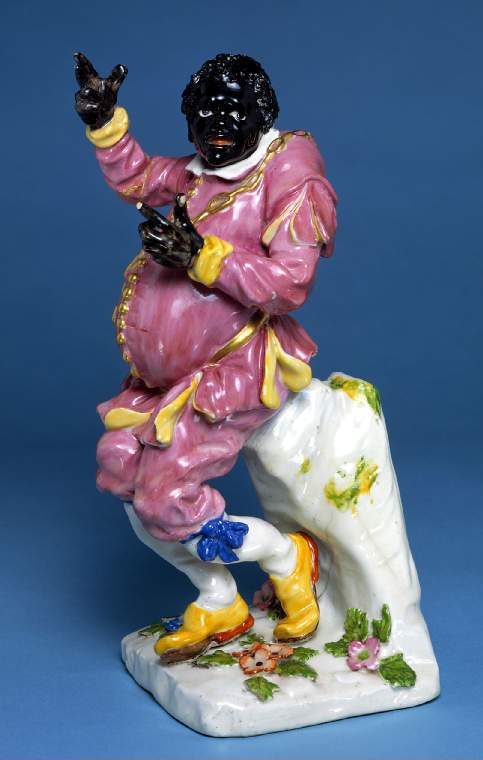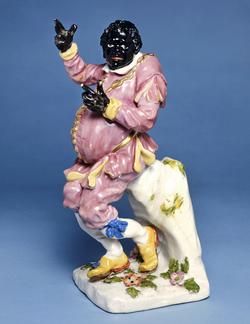Current Location: In storage
Titles
Aesop
Maker(s)
Factory:
Chelsea Porcelain Manufactory
Entities
Categories
Description
Soft-paste porcelain painted in polychrome enamels, and gilt
Soft-paste porcelain figure of Aesop, slip-cast (?), with semi-opaque lead glaze (presumably containing some tin-oxide), painted in blue, green, yellow, pink, dark pink, flesh, orange, and black enamels, and gilt. The flat, unglazed underside has a circular ventilation hole at the back. The base is approximately rectangular with a broad tree-stump and rock rising up at the back. Aesop, shown as a black man with jet black hair and skin, a hump back and pot-belly. He stands on his right foot with his left knee bent, and the foot behind him, resting his posterior on the top of the tree stump. His head is turned slightly to his left, his right arm is raised, and his left arm is bent at the elbow so that the hand at chest level. He wears a pink jacket with a white collar and yellow lining, sixteen gold buttons, and a gold belt. His matching breeches have blue bows at the knees and he has yellow shoes with orange heels and brown soles. Across his body he wears a gold chain with a watch or medallion suspended over his right side. The tree stump is decorated with a few streaks of yellow and green. The top of the base is strewn with applied flowers and leaves: on the viewer's right, a pink flower with three leaves, three orange flowers with five leaves, and on the viewer's left, two blue flowers with five leaves, and another pink flower with three leaves.
Notes
History note: Unknown before donor; Mrs W.D. (Frances Louisa) Dickson, Bournemouth
Legal notes
Given by Mrs W.D. Dickson
Measurements and weight
Depth: 13.3 cm
Height: 24.7 cm
Acquisition and important dates
Method of acquisition: Given
(1932)
by
Dickson, W. D. (Frances Louisa), Mrs
Dating
Red anchor period (1752-1756)
18th Century, Mid
George II
Production date:
circa
AD 1755
Note
This porcelain figure is thought to depict Aesop, a figure from ancient Greek history. Aesop was said to have been born into slavery, and this, coupled with a later presumption that he had come from Ethiopia, resulted in Aesop being depicted throughout the 18th century as a black man, often with crudely exaggerated features that today we may find racist and offensive.
Although Aesop is mentioned by several ancient Greek authors, almost nothing is known of his history. Aesop was probably an enslaved man who lived from c. 620-564 BCE in Phrygia (in modern Turkey) and later on the Greek island of Samos, where he was granted his freedom. It is unlikely that he was the actual author of many of the Fables now attributed to him.
Most of the story of his life comes from a much-later publication (first century CE), 'The Aesop Romance', which describes Aesop as, ‘…of loathsome aspect... potbellied, misshapen of head, snub-nosed, swarthy, dwarfish, bandy-legged, short-armed, squint-eyed, liver-lipped—a portentous monstrosity.’ This idea of Aesop as ‘ugly’ or ‘misshapen’ is a feature of all subsequent descriptions of him. Later (in the thirteenth century), a philosopher conjectured that Aesop’s name was based on his country of origin – Ethiopia, and that he had therefore been a black man. These ideas were combined and solidified in Francis Barlow’s hugely popular 'Aesop's Fables With his Life' (1687, re-published 1703). In it, Aesop is described in (what is by modern standards) a highly racist way, as,
'...of a Sharp Head, flat nos'd, his back roll'd up in a Bunch or Excrescence, his lips tumerous and pendant, his Complexion black, from which dark Tincture he contracted his name - Aesopus being the same with Aethiops [Ethiopians]...'
Although this porcelain figure was made a few decades after the publication of Barlow's book, the modeller of this figure was clearly familiar with this it, as the figure closely resembles this description and some of the illustrations (especially plates 3 and 27). However, although Aesop’s features here are crudely exaggerated, he is portrayed as elegantly and expensively dressed, with gold buttons and a watch hanging from a gold chain. To the eighteenth-century eye, these would have been clear symbols of success.
His open mouth and expansive gesture suggest that he has been caught mid-speech, and this tallies with a story from his history. According to some early biographies, Aesop was born with a speech impediment so severe that no one could understand what he said. He was cured by the goddess Isis after he showed kindness to one of her priestesses. With his tongue unknotted, he revealed himself to be supremely wise and cunning, winning fame and eventually his freedom. Do we here see an Aesop at the height of his powers, no longer enslaved, words and wit flowing from his open mouth?
This porcelain figure would have been incredibly expensive when new and therefore only available to very wealthy consumers, who purchased these ‘ornaments for dessert’ to decorate their dining table, a table that, in some cases, may have been served by a liveried black servant. Although the mid-eighteenth century witnessed the beginnings of the abolitionist movement, this figure is unlikely to be connected to it, except for the fact that ‘slaves’ in the parlance of the mid-eighteenth century were usually thought of as people of colour. Instead, this figure was intended as a talking point.
School or Style
Rococo
People, subjects and objects depicted
Components of the work
Decoration
composed of
enamels
( blue, green, yellow, pink, dark pink, flesh, orange, and black)
gold
Visible Surfaces
composed of
lead-glaze
( probably containing some tin oxide)
Base
Width 10.2 cm
Materials used in production
Soft-paste porcelain
Techniques used in production
Slip-casting
: Soft-paste porcelain, slip-cast (?), with semi-opaque lead glaze (presumably containing some tin-oxide), painted in blue, green, yellow, pink, dark pink, flesh, orange, and black enamels, and gilt. The flat, unglazed underside has a circular ventilation hole at the back
Inscription or legends present
Inscription present: a red anchor
- Text: an anchor
- Location: On proper right of the top of the base
- Method of creation: Painted in red enamel
- Type: Mark
References and bibliographic entries
Related exhibitions
Identification numbers
Accession number: C.21-1932
Primary reference Number: 47455
Stable URI
Audit data
Created: Saturday 6 August 2011
Updated: Monday 24 November 2025
Last processed: Monday 24 November 2025
Associated departments & institutions
Owner or interested party:
The Fitzwilliam Museum
Associated department:
Applied Arts





